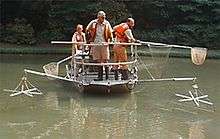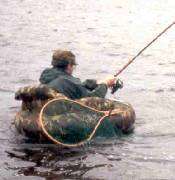Electrofishing

Electrofishing uses direct current electricity flowing between a submerged cathode and anode. This affects the movement of the fish so that they swim towards the anode where they can be caught.[1]
Electrofishing is a common scientific survey method used to sample fish populations to determine abundance, density, and species composition. When performed correctly, electrofishing results in no permanent harm to fish, which return to their natural state in as little as two minutes after being caught.[1]
Method
Electrofishing relies on two electrodes which deliver direct current at high-voltage from the anode to the cathode through the water. When a fish encounters a large enough potential gradient on this path, it becomes affected by the electricity. Usually pulsed direct current (DC) is applied, which causes galvanotaxis in the fish. Galvanotaxis is uncontrolled muscular convulsion that results in the fish swimming toward the anode. At least two people are required for an effective electrofishing crew: one to operate the anode, and the other to catch the stunned fish with a dip net.
Types

There are three types of electrofishers: backpack models, tote barge models, and boat mounted models, sometimes called a stunboat.
Backpack electrofisher generators are either battery or gas powered. They employ a transformer to pulse the current before it is delivered into the water. The anode is located at the end of a long, 2 meter pole and is usually in the form of a ring. The cathode is a long, 3 meter braided steel cable that trails behind the operator. The electrofisher is operated by a deadman's switch on the anode pole. There are a number of safety features built into newer backpack models, such as audible speakers that sound when the unit is operating, tilt-switches that incapacitate the electrofisher if the backpack is tilted more than 45 degrees, and quick-release straps to enable the user to quickly remove the electrofisher in the event of some emergency.
When boat electrofishing, the boat itself is the cathode, and the anode(s) are generally mounted off the bow. The stunned fish swim toward the anode, where they are caught alive using a dip net.[2] Towed barge electrofishers operate similarly to backpack electrofishers, with the exception that the generator is located on a floating barge instead of on a backpack. Often the barge can be left stationary on the shore and longer cathodes and anodes allow the crew to sample large areas. Barge electrofishers often employ gas-powered generators since a user does not have to carry the extra weight on his or her back.
A method of electrofishing using illegally diverted electricity from overhead electric lines is prevalent in parts of the Indian State of Kerala. This can result in accidental deaths due to electrocution.[3]
Effectiveness
The effectiveness of electrofishing is influenced by a variety of biological, technical, logistical, and environmental factors. The catch is often selectively biased as to fish size and species composition. When using pulsed DC for fishing, the pulse rate and the intensity of the electric field strongly influence the size and nature of the catch. The conductivity of the water influences the shape and extent of the electric field and thus affects the field's ability to induce capture-prone behavior in the fish.
Legal
While Electrofishing is used by multiple government agencies it may be illegal in your area to use electrofishing, or electroshock as a fishing method. This method can be considered poaching.
Florida: Illegal Statewide
See also
Notes
- 1 2 "FISHNET SHOCKINGS". Toronto Star, December 3, page IN3. Paul Hunter
- ↑ "Electro-Fishing Summary". September 2003. Archived from the original on 2007-04-03. Retrieved 2007-08-09.
- ↑ Balachandran, Ajay; Krishnan B; Lizha John (2 December 2013). "ACCIDENTAL DEATHS DUE TO ELECTROCUTION DURING AMATEUR ELECTRO-FISHING" (PDF). Journal of Evolution of Medical and Dental Sciences. 2 (48): 9376–9379. Retrieved 2 December 2013.
References
- Helfman, Gene S (2007) Fish Conservation: A Guide to Understanding and Restoring Global Aquatic Biodiversity and Fishery Resources Island Press, pp. 452–453. ISBN 978-1-55963-596-7
- Hill, David; Fasham, Matthew; Tucker, Graham; Shewry, Michael and Shaw, Philip (2005) Handbook of Biodiversity Methods: Survey, Evaluation and Monitoring Cambridge University Press, pp. 383–385. ISBN 978-0-521-82368-5
- Fishery Research - Electrofishing National Park Service, US Department of the Interior. Retrieved 2 October 2008.
- U.S. Fish and Wildlife Service (2004) Electrofishing
- Northop, Robert (1966) Electrofishing. IEEE TRANSACTIONS ON BIO-MEDICAL ENGINEERING, VOL. BME-14, NO. 3, JULY 1967
- Legal, "Florida"
External links
| Wikimedia Commons has media related to Electrofishing. |
- electrofishing.net Serving the Global Fisheries Community with Training | Tools | Research
- Delaware Division of Fish and Wildlife, Fish Monitoring via Electrofishing
- Electrofishing Effects on Endangered Fishes
- International electrofishing email forum
- Electrofishing

